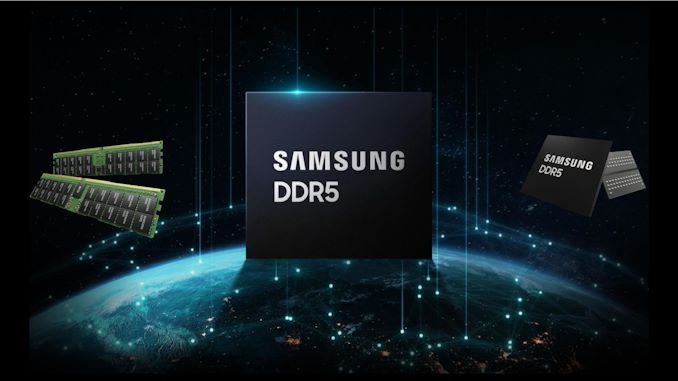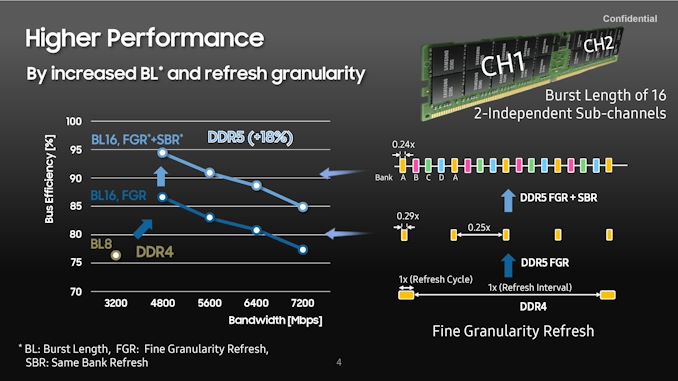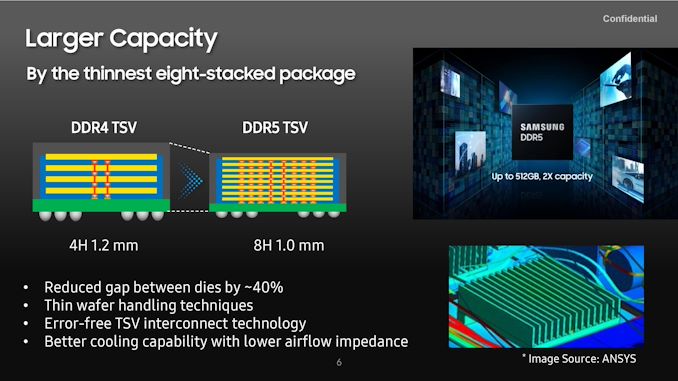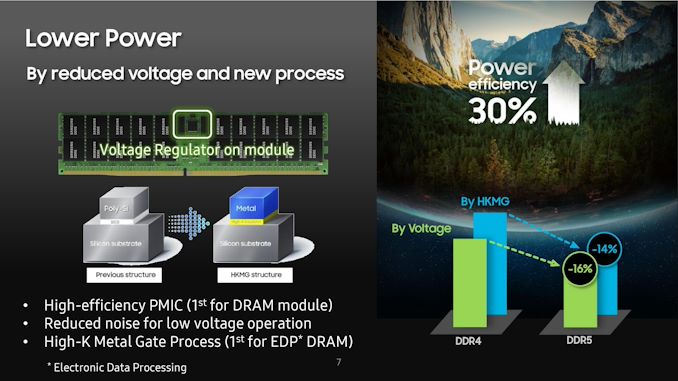
[ad_1]
This week, as part of the annual Hot Chips Semiconductor Conference, Samsung’s memory division presented a poster / slides on a project they are currently working on with impressive final results. The company details a 512 GB DDR5 memory module, running on DDR5-7200, designed for server and enterprise use. This is a step up from the high-end 256GB modules in the current market, but to achieve this, Samsung has introduced new features and functionality.
As per standard DDR5 spec, the modules will run at 1.1 volts with standard JEDEC DDR5-7200 timings, but even JEDEC has not declared an official DDR5-7200 standard at this point, choosing only to go DDR5- 6400. There are placeholders for future standards, such as DDR5-7200, and depending on increasing latencies from slower speed to higher speed, these should be between 50-50-50 and 60-60-60 *.
*There are three variations for each DDR5 standard – A, B, or C.
DDR5-6400A is 46-46-46 for example, but
DDR5-6400C is 56-56-56.
As part of the presentation, Samsung states that the introduction of Same-Bank (SBR) refresh in its DDR5 will increase the DRAM bus connectivity efficiency by nearly 10%, with DDR4-4800 showing the highest efficiency in terms of bit energy. .
In order to support the higher memory transfer rates of DDR5, Samsung introduced a new DFE (Decision Feedback Equalizer) for better signal stability. It allows for a more variable data path location, as well as spindle calibration techniques.
One of the main benefits of increasing memory capacity is that you end up stacking more memory. For its part, Samsung states that they can stack 8 DDR5 arrays together and still be smaller than 4 DDR4 arrays. This is achieved by thinning each die, but also by new connection topographies through silicon-via which allow a reduced gap between the dies of up to 40%. This is combined with new cooling technologies between the dies to improve thermal performance.
As for the power supply, we know that one of the drivers of the latest memory spec from JEDEC is lower wattage, and for DDR5 the main thing besides lower voltage is to bring the voltage regulator from motherboard onto the memory module. This allows the memory module manufacturer to more closely control power requirements and memory consumption, especially if the motherboard is a very inexpensive model that could skimp on valuable components in voltage regulation. For this 512 GB module, Samsung uses a high efficiency power management integrated circuit (PMIC). As a company, Samsung has a lot of experience in PMIC through its other electronics divisions. So there is no doubt that they can achieve high efficiency here. Samsung also claims that its PMIC has reduced noise, allowing low voltage operation, and also uses a High-K Metal Gate process (introduced on 45nm processors) in a first for DRAM.
One of the talking points for DDR5 has been on-chip ECC (ODECC) functionality, built into DDR5 to help improve memory efficiency by launching a per-chip ECC topology. The confusion is that this is not a true ECC activation on a DDR5 module, which still requires additional physical memory and a protected bus. But on ODECC, Samsung shows an improvement in its bit error rate of 10-6, or a BER less than a million. It is unclear how much the DDR5 JEDEC specification requires at this point, but it’s still a good direction to go.
At the end of Samsung’s slideshow, it says its first 512GB module is expected to be ready for mass production by the end of 2021 – it’s unclear if it’s a DDR5-7200 module. or whatever, because the slide could be interpreted differently. But one of the key aspects of this discussion is when the market expects the crossover of DDR4 and DDR5 to happen: Samsung has a big window of 2023-2024 slated for this crossover, which is in line with the forecast. other market analysts.
This stuff is going to cost a lot of money again, which makes me wonder what this means for consumers. Right now, the 32GB module (UDIMM) offering seems to be plentiful for those who want 128GB of memory in a mainstream system. The advent of these new memory packages from Samsung might suggest a path to 64GB modules for DDR5 on the mainstream platform, but you can bet your bottom dollar that they will stay with the company for a while. because they will cost more.
Stay tuned for Hot Chips content from AnandTech throughout this week.
[ad_2]




